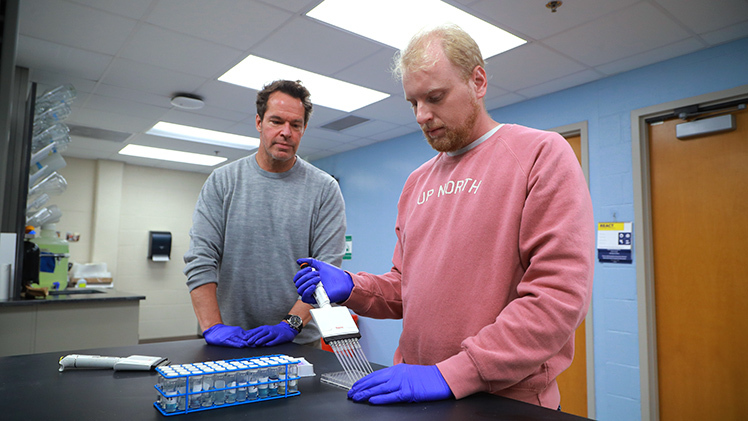Local beachgoers know to stay out of the water when the pea-green expanse of a harmful algal bloom settles into Maumee Bay.
But what about the sand?

Garrett Moots, right, a doctoral student studying ecology and organismal biology, led research into algal toxins and beach sands with Dr. Von Sigler, left, a professor of environmental microbiology.
University of Toledo microbiologists explored the question in recently published research in the peer-reviewed Journal of Great Lakes Research. Through laboratory tests on a season’s worth of sand and water samples from Maumee Bay State Park in Oregon, Ohio, they documented the accumulation of an algal toxin in the portion of the beach that is regularly inundated by lake waves — and established that it sticks around for up to three weeks.
“So even if the water tests clean, the sand might not,” UToledo doctoral student Garrett Moots said.
Moots, who is studying ecology and organismal biology, led the research under Dr. Von Sigler, a professor of environmental microbiology in the Department of Environmental Sciences. Their work furthers an extensive and discipline-crossing body of research into harmful algal blooms at UToledo, which for more than a decade has been at the forefront of efforts to protect water quality and the health of Lake Erie.
While UToledo and other institutions have invested heavily in research into harmful algal blooms, Sigler and Moots noticed the majority of this work was within the context of water. They wondered what blooms might mean for families enjoying a day on the beach.
“If you go to the beach you’ll see people in the water, but mostly you’ll see kids in the sand. They’re digging holes, they’re building sandcastles, they’re burying themselves in it,” Sigler said. “We thought, if there’s toxin in the lake, and the water is washing onto the sand, then there’s probably toxin in the sand. We were really interested in seeing how persistent that toxin was and if there might be a potential for human exposure.”
Sigler and Moots found a dearth of published research on the topic. So supported by the Ohio Department of Higher Education’s Harmful Algal Bloom Research Initiative, which funds applied research at universities across the state, the researchers and their collaborators set up field study and laboratory-based experiment to study the persistence of microcystin, a toxin produced by the cyanobacteria that make up harmful algal blooms, in the foreshore sands of Maumee Bay State Park.
Moots and laboratory technicians Kayla Kinzel and Chelsey Suffety collected samples from three of six man-made coves along the public beach weekly between June and September in 2022. The research team also included UToledo’s Dr. Daryl Dwyer and Dr. Daryl Moorhead and former faculty member Dr. Jason Huntley. While the researchers noted dramatic variation across sampling sites, they found evidence of overall accumulation of microcystin, with concentrations in sand exceeding those in water in more than half of the samples.
They also documented the persistence of the toxin for between 21 and 28 days.
Moots completed the research while earning a master’s degree in ecology organismal biology at UToledo. He’s now advancing it through his ongoing doctoral dissertation, in which he aims to further explore how environmental factors like wind speed and current direction affect when and where the toxin accumulates in research that could inform future beach management decisions.
He also aims to explore what sand exposure might mean for human health.
The latter is a point that the researchers notably did not address in their current research, although Sigler and Moots suggest that beachgoers can take their findings with a grain of salt — or perhaps sand. Among those with healthy immune systems and without cuts, scrapes or other damage to their skin, exposure to microcystin via the skin is not known to cause serious health concerns.
“Just because it’s out there doesn’t mean someone is going to get sick if they contact it,” Sigler said.